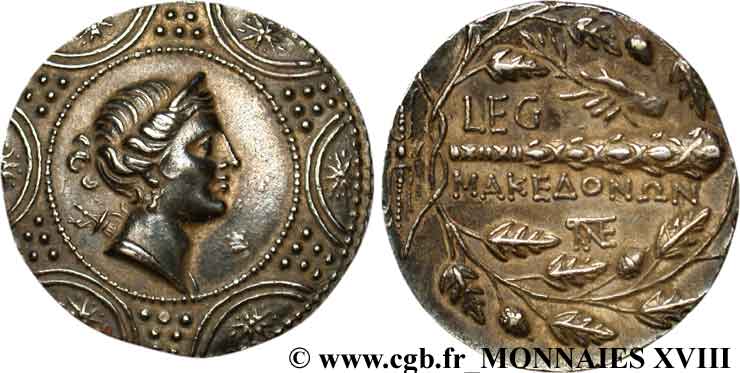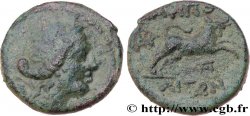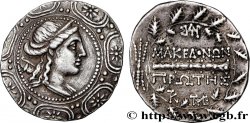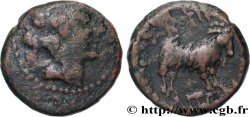v18_0060 - MACEDONIA - AMFIPOLIS Tétradrachme stéphanophore
MONNAIES 18 (2003)
Начальная цена : 950.00 €
Назначить цену : 1 800.00 €
Цена реализации : 2 460.00 €
Количество ставок : 9
Максимальная предлагаемая цена : 2 915.00 €
Начальная цена : 950.00 €
Назначить цену : 1 800.00 €
Цена реализации : 2 460.00 €
Количество ставок : 9
Максимальная предлагаемая цена : 2 915.00 €
Тип Tétradrachme stéphanophore
Дата: c. 148-147 AC.
Монетный двор / Город: Macédoine, Amphipolis
Металл: silver
Диаметр: 29,5 mm
Ориентация осей монеты: 3 h.
Вес: 16,74 g.
Редкость: R2
Emission: 2e
Комментарии о состоянии
Exemplaire de qualité exceptionnelle pour ce type de monnayage avec une extraordinaire patine de médaillier à reflets gris bleutés, mordorés au revers. Revers de toute beauté, parfaitement centré
Ссылки в каталоге: :
Происхождение:
Cet exemplaire provient d’une vieille collection des années 30
Лицевая сторона
Аверс: легенда: ANÉPIGRAPHE.
Аверс: описание: Buste diadèmé et drapé d'Artémis Tauropolos à droite, l'arc et le carquois sur l'épaule, placé au centre d'un bouclier macédonien orné d'étoiles.
Обратная сторона
Реверс: легенда: LEG/.
Реверс: Описание: de chaque côté d'une massue ; au-dessus, main tenant un rameau d’olivier ; au-dessous, un monogramme ; le tout dans une couronne de chêne fermée par un foudre.
Реверс: легенда: MAKEDONWN
Комментарий
Le seul autre exemplaire connu avec ce monogramme provient de la vente de la liste Ratto 6 (1922), n° 1305, de la vente Ratto du 4 avril 1927, n° 769, de la vente Baranowsky du 25 février 1931, n° 460 et de la liste Ratto 14 (1935), n° 1618. Il est de mêmes coins que notre tétradrachme, celui-ci étant en meilleur état. L’axe des coins pourrait être à 6 heures, la massue étant alors placée verticalement.
The only other known example with this monogram comes from the sale of Ratto list 6 (1922), no. 1305, from the Ratto sale of April 4, 1927, no. 769, from the Baranowsky sale of February 25, 1931, no. 460 and from the Ratto list 14 (1935), no. 1618. It has the same dies as our tetradrachm, the latter being in better condition. The die axis could be at 6 o'clock, the club then being placed vertically
The only other known example with this monogram comes from the sale of Ratto list 6 (1922), no. 1305, from the Ratto sale of April 4, 1927, no. 769, from the Baranowsky sale of February 25, 1931, no. 460 and from the Ratto list 14 (1935), no. 1618. It has the same dies as our tetradrachm, the latter being in better condition. The die axis could be at 6 o'clock, the club then being placed vertically








 Cообщить об ошибке
Cообщить об ошибке Распечатать страницу
Распечатать страницу Отправить мой выбор
Отправить мой выбор Задать вопрос
Задать вопрос Consign / sell
Consign / sell
 Информация
Информация










